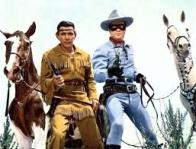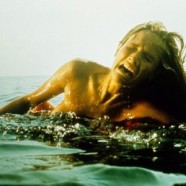PART TWO – THE REDEMPTION HERO
Joseph Campbell found his three-phase “monomyth” of the hero in almost all cultures; everywhere, that is, except in America. Why is this so? America lacks its own indigenous myths, except of course for the Native American myths that were actually nurtured by this land. But European conquerors and settlers, long alienated from their own indigenous roots, brought only the stories of Puritanism, materialism, progress, chosen people and hatred of the “Other” with them. Conditions were ripe for the creation of something new. And that is exactly what happened: the American myth is the story of something distinctive and original.
Four hundred years of unique historic circumstances, idealistic story telling, preaching, movies, advertising and deliberate propaganda have created an American monomyth, with its own American type of hero. He is individualistic, lonely, selfless, possessed of extraordinary powers – and, as I mentioned above, surprisingly sexless. Though he first appears as the frontiersman and matures into the cowboy, he reappears as the detective, the Lone Ranger, the superhero and Rambo.
Campbell’s classic hero of a thousand faces is born in community; he hears a call, ventures forth on his initiatory journey and returns, often sadder but wiser. But the American hero comes from elsewhere, entering the innocent community so as to defend it from malevolent attacks that also originate elsewhere. The leaders of this community are weak, incompetent or corrupt. Though the hero cares deeply about them, he is not one of them.
Often his very identity is a secret; he may wear a mask or bizarre costume.  https://madnessatthegates.files.wordpress.com/2017/12/unknown.jpeg?w=150&h=114 150w, https://madnessatthegates.files.wordpress.com/2017/12/unknown.jpeg 257w" sizes="(max-width: 196px) 100vw, 196px" style="background-color: transparent; border: 0px; margin: 4px 0px 12px 24px; padding: 0px; vertical-align: baseline; display: inline; float: right; background-xg-p: initial initial; background-repeat: initial initial;" width="196" height="150" /> He is usually without flaw but also without depth. Perhaps he fears the public exposure of that secret identity – that he really isn’t very special.
https://madnessatthegates.files.wordpress.com/2017/12/unknown.jpeg?w=150&h=114 150w, https://madnessatthegates.files.wordpress.com/2017/12/unknown.jpeg 257w" sizes="(max-width: 196px) 100vw, 196px" style="background-color: transparent; border: 0px; margin: 4px 0px 12px 24px; padding: 0px; vertical-align: baseline; display: inline; float: right; background-xg-p: initial initial; background-repeat: initial initial;" width="196" height="150" /> He is usually without flaw but also without depth. Perhaps he fears the public exposure of that secret identity – that he really isn’t very special.
The classic hero often meets and weds the beautiful maiden or princess, enacting the ancient (and inner) union that the Greeks called hieros gamos. They produce many children; indeed, aristocracies everywhere legitimize themselves through genealogies that claim to descend from gods and heroes.
But the American hero (exceptions include James Bond parodies and Woody Allen-type antiheroes)  https://madnessatthegates.files.wordpress.com/2017/12/woody-allen-cinematheia-com_.jpg?w=452&h=254 452w, https://madnessatthegates.files.wordpress.com/2017/12/woody-allen-cinematheia-com_.jpg?w=150&h=84 150w, https://madnessatthegates.files.wordpress.com/2017/12/woody-allen-cinematheia-com_.jpg?w=300&h=169 300w" sizes="(max-width: 226px) 100vw, 226px" style="background-color: transparent; border: 0px; margin: 4px 24px 12px 0px; padding: 0px; vertical-align: baseline; display: inline; float: left; background-xg-p: initial initial; background-repeat: initial initial;" width="226" height="127" /> doesn’t get or often, even want the girl. Even Bond, in his hyper-sexuality, remains a bachelor. More often, the hero must choose between an attractive sexual partner and his sense of duty to his mission; he cannot have both. Some, such as Batman and the Lone Ranger, prefer a comical male “sidekick.”
https://madnessatthegates.files.wordpress.com/2017/12/woody-allen-cinematheia-com_.jpg?w=452&h=254 452w, https://madnessatthegates.files.wordpress.com/2017/12/woody-allen-cinematheia-com_.jpg?w=150&h=84 150w, https://madnessatthegates.files.wordpress.com/2017/12/woody-allen-cinematheia-com_.jpg?w=300&h=169 300w" sizes="(max-width: 226px) 100vw, 226px" style="background-color: transparent; border: 0px; margin: 4px 24px 12px 0px; padding: 0px; vertical-align: baseline; display: inline; float: left; background-xg-p: initial initial; background-repeat: initial initial;" width="226" height="127" /> doesn’t get or often, even want the girl. Even Bond, in his hyper-sexuality, remains a bachelor. More often, the hero must choose between an attractive sexual partner and his sense of duty to his mission; he cannot have both. Some, such as Batman and the Lone Ranger, prefer a comical male “sidekick.”
How common is this unattached hero? Here are some others:
Hawkeye, the Virginian, Josey Wales, Paladin, Sam Spade, Nick Danger, Mike Hammer, Phillip Marlowe, Sherlock Holmes, Hercule Poirot, Dirty Harry, John Shaft, Indiana Jones, Robert Langdon, Mr. Spock, Obi-Wan Kenobi, Yoda, the Man With No Name, the Hobbits, Gandalf, Mad Max, Superman, Green Lantern, Green Hornet, Spiderman, the Hulk, Iron Man, Human Torch, The Flash, Dr. Strange, Hellboy, Nick Fury, Swamp Thing, Aquaman, Daredevil, Lone Wolf McQuade, Sargent Rock, Braveheart, Conan the Barbarian, Jack Sparrow, Captains Kirk, Picard, Atom, Nemo, Phillips, Marvel and America and the heroes of Death Wish, The Magnificent Seven, The Dirty Dozen, Pale Rider, Unforgiven, Under Siege, Lethal Weapon, Blade, Casablanca, One Flew Over The Cuckoo’s Nest, No Country for Old Men, Gran Torino, Walking Tall, Delta Force, Missing In Action, Avenger, Extreme Justice, The Equalizer, Terminator, The Exterminator, Rawhide, The Rifleman, Million Dollar Baby, Open Range and The Exorcist.
All are single, divorced or (especially in John Wayne’s movies) widowers. Jewett and Lawrence write, “The purity of his motivations ensures moral infallibility,” but denies both the tragic complexity of the real world as well as the possibility of healing through merging with and incorporating the values of the Other.
Indeed the sexual impurity of others often seems to invite evil into innocent Eden. In recent decades the hero often enacts his savior role in disaster films (Earthquake, Jurassic Park, Towering Inferno, Tidal Wave and especially Jaws). Commonly, the sexual license of certain (usually female) characters seems to trigger the destruction, and such sinful figures are the first to be destroyed. Nature responds with a moral cleansing, reminding us again of the Puritan underpinnings of our culture. The pattern was set in the Old Testament: “Sexual improprieties provoke natural disasters, from which only the pure and faithful will escape.”
The first victim in Jaws is a sexually provocative woman.  https://madnessatthegates.files.wordpress.com/2017/12/v1-bjsymtk4mza7ajsxnzu1mjsxmjawozu3njs0mzi.jpeg?w=150&h=150 150w, https://madnessatthegates.files.wordpress.com/2017/12/v1-bjsymtk4mza7ajsxnzu1mjsxmjawozu3njs0mzi.jpeg 300w" sizes="(max-width: 186px) 100vw, 186px" style="background-color: transparent; border: 0px; margin: 4px 0px 12px 24px; padding: 0px; vertical-align: baseline; display: inline; float: right; background-xg-p: initial initial; background-repeat: initial initial;" width="186" height="186" /> And the final scene, in which the hero (who has refused to make love to his wife) destroys the giant shark, perfectly recreates Marduk’s ancient killing of Tiamat. Four thousand years after Babylonians first told that myth, the male hero must still conquer the feminine serpent.
https://madnessatthegates.files.wordpress.com/2017/12/v1-bjsymtk4mza7ajsxnzu1mjsxmjawozu3njs0mzi.jpeg?w=150&h=150 150w, https://madnessatthegates.files.wordpress.com/2017/12/v1-bjsymtk4mza7ajsxnzu1mjsxmjawozu3njs0mzi.jpeg 300w" sizes="(max-width: 186px) 100vw, 186px" style="background-color: transparent; border: 0px; margin: 4px 0px 12px 24px; padding: 0px; vertical-align: baseline; display: inline; float: right; background-xg-p: initial initial; background-repeat: initial initial;" width="186" height="186" /> And the final scene, in which the hero (who has refused to make love to his wife) destroys the giant shark, perfectly recreates Marduk’s ancient killing of Tiamat. Four thousand years after Babylonians first told that myth, the male hero must still conquer the feminine serpent.
The classic hero undergoes the torments of initiation so that both he and his community may suffer into knowledge, that the world may be re-created. It is a pagan and tragic vision; something must die – his old self – in order for new life to grow. But the American hero cares only for the selfless redemption (Latin: “to buy back”) of others. Born in a monotheistic vision, he saves Eden by combining elements of the sacrificial Christ and the zealous, omnipotent Yahweh. Both he and his community begin and end in innocence, because evil, defeated or not, is out there.
The American psyche has been preoccupied for centuries with the question of salvation. And the triumph of the secular world did not eliminate the Puritan’s longing for redemption; it merely displaced it onto fictional heroes – or onto the inhabitants of the lands where we take our crusades for democracy, people who are in need of our help.
I cannot emphasize this basic insight too strongly. The redemption hero is the logical conclusion to a process of abstraction, alienation and splitting of the western psyche that has gone on for millennia. He is utterly (and proudly) disconnected from relationship with the Other, whom he has demonized into his mirror opposite. Because the Other is irredeemably evil, there is no reason to bemoan the level of violence employed in his destruction, nor to mourn his death (nor, as we will see, to mourn the death of the Hero himself).
The hero’s unwillingness to confront these emotional realities continually reinforces that other American myth, the denial of death.
As Jewett John Lawrence have taught, this hero requires no emotional nurturance, doesn’t grow in wisdom or create anything, and teaches nothing but the resolution of problems through violence. His Puritan renunciation and self-control justify his unlimited capacity for vengeance, which clearly has had a modeling effect on millions of adolescent males. His appeal lies deep below the level of rational thinking. He offers “vigilantism without lawlessness, sexual repression without resultant perversion, and moral infallibility without the use of intellect.” And – this is critical – claiming to love democracy, he never practices citizenship, resorting regularly to unlawful means.
In a parallel tradition, heroines perform their redemptive roles non-violently. Ranging from Heidi and Pollyanna to the heroines of The Wizard of Oz, The Sound of Music, Little House On The Prairie and the Nancy Drew mysteries, they are the secular replacements for a culture that has lost faith in the Virgin Mary and her angels. Untainted by sexual passion, they transform villains with cheerful love, always producing happy endings, regardless of real human complexities. Like their male counterparts, they restore the moral order and avert the threat of random, Dionysian chaos.
These images are the popular expression of civic religion, or national mythology, or in Campbell’s terms, the sociological function of myth. What academics call the “secular displacement of religion,” a pagan like Caroline Casey would call the “toxic mimic.”
To summarize: American literary, religious, political and mass media traditions created and continue to sustain an image of the hero which is the inversion, or literalization of the “Hero With a Thousand Faces.” Rather than growing out of rites of initiation – dying and recreation of the world – it combines the figure who dies for the world with his all-powerful and vengeful father. Superhuman abilities reflect a hope of divine redemption that science has never eradicated, as well as the idea that democracy can be redeemed by anti-democratic means, that peace comes through violence.
History leads to mythology, and the constant repetition of mythic images socializes new generations of young people, some of whom will work in careers that help to directly perpetuate the myths – and history. Another generation learns that their community (we,the “not-others”) is completely innocent, and exceptional. Nature remains outside, of no potential help, except as moral cleansing agent.
The hero, instead of losing his own innocence and bringing wisdom to integrate into his community, remains one-dimensional as he restores the innocent community. Neither grows in wisdom. There is no meaningful suffering, no initiation, and nothing new is created to pass on to future generations. Such communities are compelled to repeat their unconscious, vicarious search for the Other. They will find it behind every bush, in every slum that breeds more terrorists. It is as if Campbell’s hero has become an anonymous and pathological killer in search of an enemy with a thousand faces.